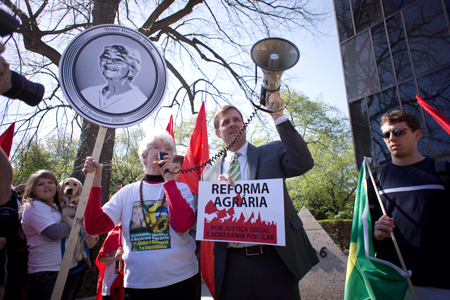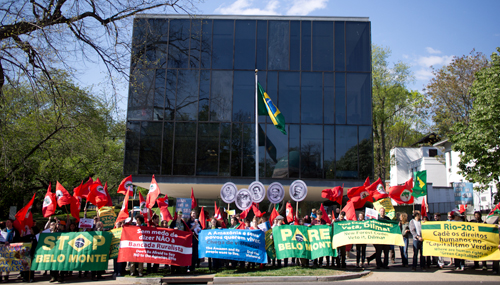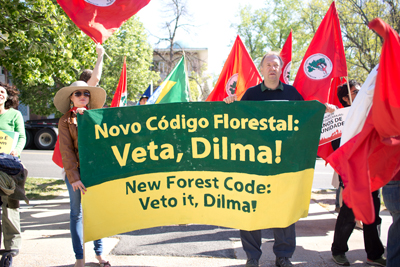In Dilma Visit, Protesters Recall Martyrs of the Amazon
By Felipe Milanez in Washington
The Embassy of Brazil in Washington, a modernist building that contrasts with the classical properties of the beautiful Embassy Row, the sector of embassies of the U.S. capital, hosted on Monday April 9th a march that brought together about one hundred people, including students, activists and Brazilians living in the region, who demonstrated during the visit of President Rousseff the city.
The protest, according to organizers, had four reasons: the violence in the countryside, especially in the Amazon; the impunity of the masterminds and executors of these crimes; changes in the Brazilian Forestry Code; and the construction of large dams in the Amazon.
Amid the flags of the Movement of Landless Rural Workers (MST), posters stamped images of the couple José Cláudio Ribeiro da Silva and Maria do Espirito Santo da Silva, murdered on May 24, 2011. They were next to pictures of Dorothy Stang, Chico Mendes and a scene of the burial of 19 landless workers killed in the massacre of Eldorado dos Carajas in 1996.
"The Amazon and its people want to live. No more violence." This was the phrase emblazoned on a banner.
The theme refers to a dramatic situation in the Amazon: the assassination of political leaders in the region. Photos of Laisa Santos Sampaio and Nilcilene Miguel de Lima came accompanied by the following sentence, pronounced by activists recently: "I want to live."
 The same sentence was spoken by Chico Mendes shortly before his death. Nilcilene is under protection of the National Force (whose term ends soon). Laisa, also received death threats, and continues working without any official protection.
The same sentence was spoken by Chico Mendes shortly before his death. Nilcilene is under protection of the National Force (whose term ends soon). Laisa, also received death threats, and continues working without any official protection.
Marguerite Hohm, sister of missionary Dorothy Stang, assassinated in Pará in 2005, provided solidarity with the activists who have received death threats in the region. "Enough of violence in the Amazon," she said.
After serving part of their sentences, some of those involved in the death of Dorothy, such as Bida, one of the instigators, and Fogoió, one of the executors, are already free.
The mobilizing motto's included social and environmental slogans, against the Belo Monte Dam ("Stop Belo Monte"), the Forest Code in a vote in the Brazilian House of deputies ("Veto, Dilma!"), "Don’t be afraid to say no to the ruralist block of Congress” [the rural elites block of congress people], and in defense of traditional forest peoples "Indians, gatherers and peasants, doctors of ecology."
Miguel Carter, a professor at American University, said that the present need for reflection. "It is not known how long we can carry this life on the planet the way we take today. And you must listen to the Indians, Amazonian peoples, peasants, people who know more about ecology than the politicians who are negotiating international agreements. "
He said the traditional people "are the real doctors of ecology. We must have the humility to recognize their wisdom, for we have much to learn."
Zé Cladio and Maria, honored in May by the UN as "Heroes of the Forest," were highlighted by Carter as "heroes by the movement of human rights and the environment."
"This is a march of solidarity with the Brazilian social movements, human rights advocates, environmental activists, indigenous peoples, peasant movements. And also to protest against the government's environmental policy, "said Andrew Miller, the organization Amazon Watch, in the loudspeaker.
"Dilma Rousseff is showing Brazil as a progressive country with respect to the environment, aiming at the Rio + 20. But the situation on the ground shows a different reality, with the construction of large dams in the Amazon, like Belo Monte, the Forest Code, if Dilma in case she ratifies the law, and especially with the serious situation of violence in the region, "said Miller.
The speech came with banners in the background asking, "Rio-20: where are human rights in the 'green capitalism'?".
The organizations present remembered that "deforestation tripled in the first quarter of this year." "Along the forest, the Amazon people are being killed," Laisa had said in his UN speech, accepting the award in honor of his sister and his brother.
Violence is one of the most frightening factors in the Amazon. The death of the couple of environmentalists in Pará, less than a year ago, was followed by the death of Adelino Ramos, Dinho, in Rondônia, in the same week. In the same region where Dinho denounced the illegal extraction of timber, on March 30, less than two weeks before the march on Washington, Dinhana Nink was killed for the same reason: to report illegal loggers. Nilcilene Lima, leader against the timber extraction, fears the same fate.
"Our sympathies to those who know that we are far from them. The Brazilian government cannot remain silent," says Carter.
The march took place in a beautiful spring day in the U.S. capital, with the way colored by flowers, especially the famous cherry trees that bloom this time of year.
The posters, designed by artist Cesar Maxit, composed a poetic landscape and at the same time, disturbing. Less than a year after being murdered, Zé Cláudio and Maria had their faces placed next to the emblematic figures of the destruction of the Amazon, Chico Mendes and Dorothy Stang.
They became exactly what, in life, was feared: the martyrs of the Amazon. "The same thing they did with Chico Mendes, the same thing they did with her sister Dorothy, they want to do with me," Zé Cláudio had said, in the event TEDXAmazonia, a few months before his death.
The posters with the clamor of life of Laisa and Nilcilene, "I want to live," may represent hundreds of people who are threatened with death, in lists discussed by social movements with the government.
The government's failure to give these people the conditions to be able to survive in an environment dominated by fear and terror, makes fearing the worst.
